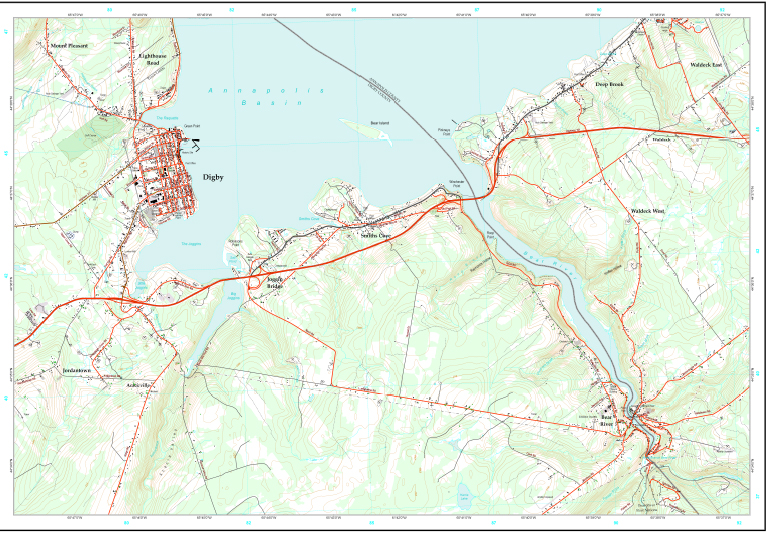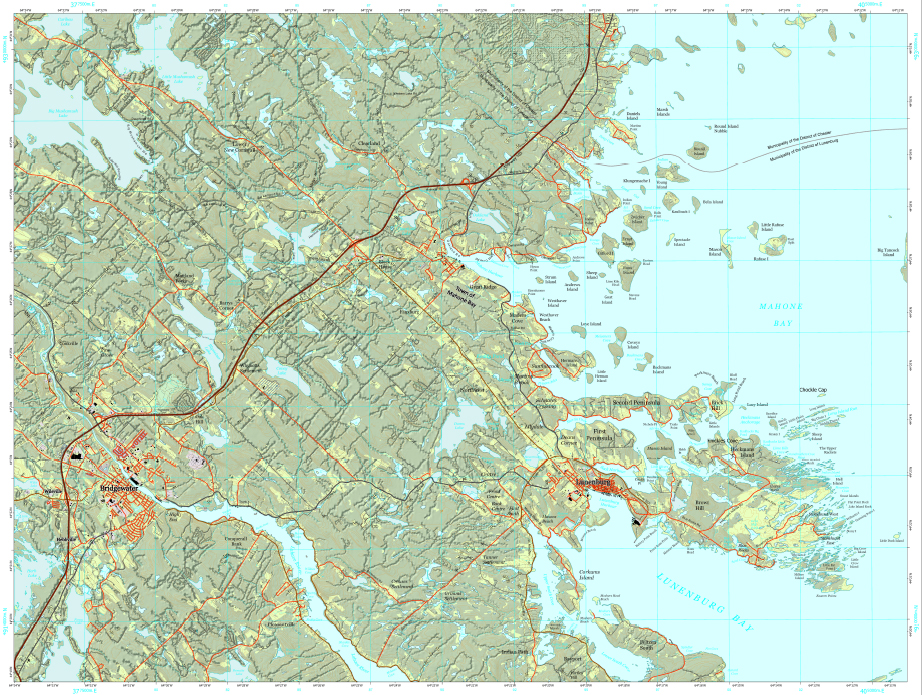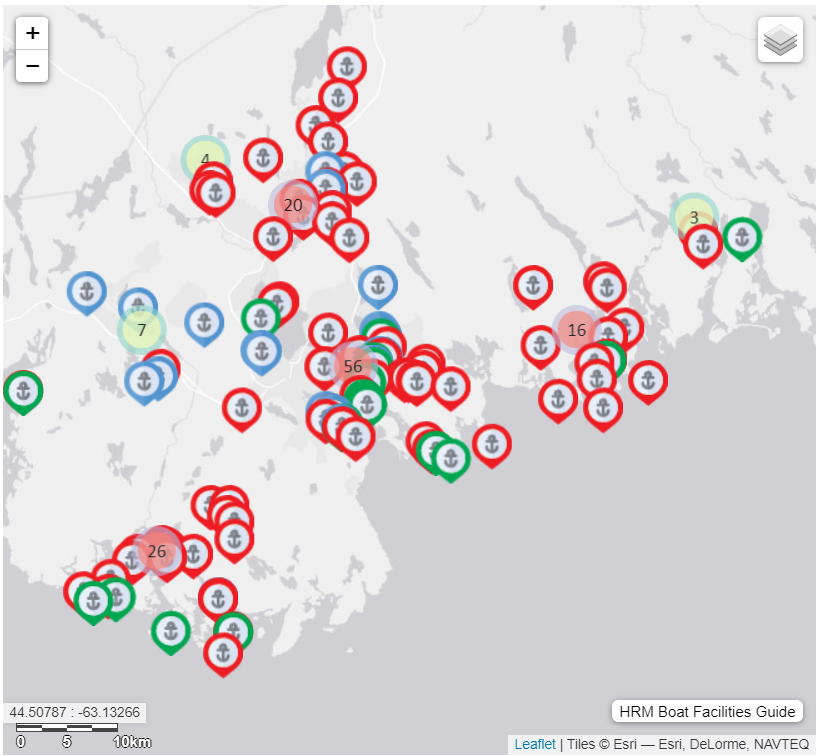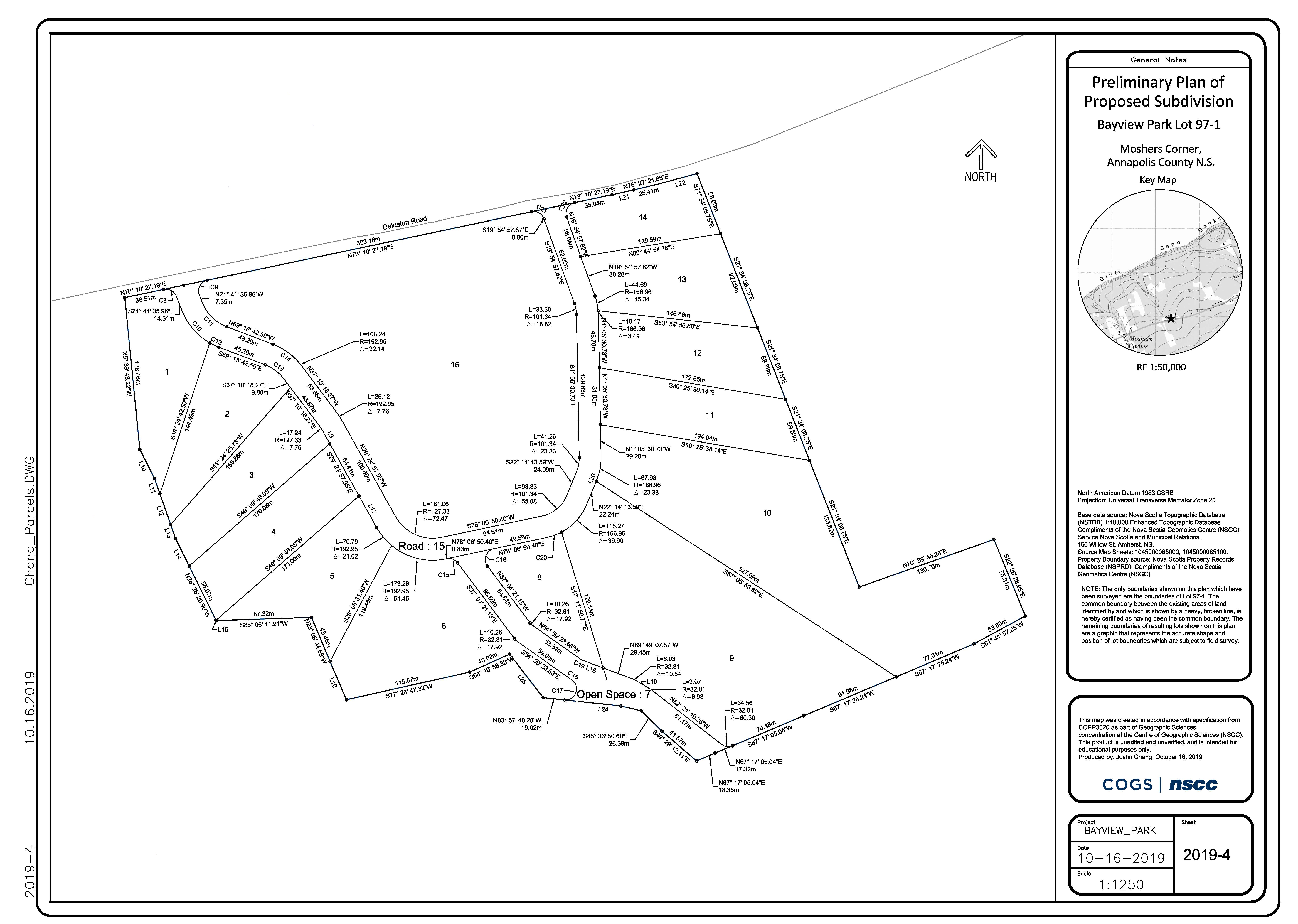Geographic Information System (GIS)
 See Map
See Map
Objective
- Create a basemap of Digby using vector and raster data.
- Symbolize and annotate the map using cartographic principles.
Equipment/Software
- Esri ArcMap 10.6
- Esri ArcCatalog 10.6
Process
Base source for the study area of Digby was downloaded from the Nova Scotia Topographic Database(NSTDB) 1:10000 Enhanced Topographic Data Base. The key map source was a custom theme layer compliments of the Nova Scotia Geomatics Centre (NSGC) Service Nova Scotia and Municipal Relations. The map data of the study area was clipped and merged to the dimensions of the study area. Then the study area was symbolized using cartographic principles. For the annotation of the map, GeoNames from the province of Nova Scotia was used to label the features using the Esri Standard label engine and was later annotated and edited. Furthermore, forested polygon feature class was created using Nova Scotia Department of Natural Resources Forest inventory database.
Geographic Information System (GIS)
 See Map
See Map
Objective
- Create a topographic map of Lunenburg and Bridgewater using hillshades.
- Symbolize and annotate the map using cartographic principles.
Equipment/Software
- Esri ArcGIS Pro 2.2.4
Process
Base source for the study area of Lunenburg was downloaded from the Nova Scotia Topographic Database(NSTDB). The key map source was a custom theme layer compliments of the Nova Scotia Geomatics Centre (NSGC) Service Nova Scotia and Municipal Relations.The map data of the study area was clipped and merged to the dimensions of the study area. The study area was then symbolized using cartographic principles. For the annotation of the map, GeoNames from the province of Nova Scotia was used to label the features using the Esri Standard label engine and was later annotated and edited. Furthermore, forested polygon feature class was created using Nova Scotia Department of Natural Resources Forest inventory database.
Cartography
 See Map
See Map
Objective
- Create statistical maps using Population Pyramids.
Equipment/Software
- Adobe Illustrator CC
- Adobe InDesign CC
- Adobe Photoshop CC
- Esri ArcMap 10.6
- Microsoft Excel
Process
Boundary files of Nova Scotia counties were downloaded and edited to create basemap of Nova Scotia using the statistics Canada Boundary Shapefiles. Esri ArcMap was used to edit the shapefiles while Adobe Illustrator was used to design and create the details of each map. For the Population Pyramid, 2016 statistics Canada Census Profile was downloaded and edited using Microsoft Excel. Then a Population Pyramid for each county was created to form a Population Pyramid Map of Nova Scotia.
Cartography
 See Map
See Map
Objective
- Create a thematic map poster, based on topic of choice.
- Combines graphical and textual elements to tell a story.
- Must include at least one chart, graph or illustrations.
Equipment/Software
- Adobe Illustrator CC
- Adobe InDesign CC
- Adobe Photoshop CC
- Esri ArcMap 10.6
- Microsoft Excel
Process
Base data was downloaded from Natural Earth website. The data was then queried, processed and fine-tuned to fit the purpose of this map, which was draw a thematic map poster of Canada. Map data was then exported as Illustrator file format (.ai) and was subsequently edited in Adobe Illustrator CC. Edit of map included drawing symbols and ribbon logos with the pen tool in Adobe Illustrator CC program. Using Microsoft Excel spreadsheets, data was then processed to make pie charts and charts for the two small maps created for the thematic map poster project. Colours of each NHL teams were applied to the charts and was used to depict the dominance of teams in each provice area used for the map. Upon completing each small map, the maps were then edited for the final time on Adobe InDesign for print. Logos of NHL teams as well as text explaining the rich history of Canadian NHL teams was explained.
Web Mapping
 See Map
See Map
Objective
- Create a web map using HTML,CSS and JavaScript.
- Use Leaflet to build the web map.
- Use shape files and GeoJSON files.
Equipment/Software
- QGIS
- Leaflet
- Atom text editor
- Adobe Illustrator CC
Process
For this map, a map of boat facilities in Halifax Regional Municipality, Nova Scotia, Canada were mapped using open data from Halifax Open Data Portal. The data was downloaded as a shapefile then it was converted to a GeoJSON file using QGIS. Using the Atom text editor, the Geojson file was converted to JavaScript file. Then the basis of the web map was made customizing the basic template provided by Leaflet. Markers, marker clusters, scale, mouse position control and legend were added to the map. Markers were created/edited using Adobe Illustrator and “if” statement was used to show different attributes on a map. As the original data regarding the attributes(Boat Dock, Boat Launch and Wharf) were strings, each form of boat facility was given a coded value to execute the “if” statement in JavaScript. Also in the process, a basemap with multiple basemap layers were created to toggle between different basemap layers.
Computer-aided design (CAD)
 See Map
See Map
Objective
- Create a parcel using AutoCAD Civil 3D.
- Use Parcel Creation Tools to subdivide parcels.
- Label lot lines and add iron pins to lots.
Equipment/Software
- Autodesk AutoCAD Civil 3D
Process
A parcel was made using the provided AOI file. After a stream alignment was created, a ROW parcel was created along the stream. Parcels were then subdivided using the Parcel Creation Tools, which was then subdivided into single family lots using the specification of Kings County. Lot lines were then labelled and iron pins were added to the lots.
